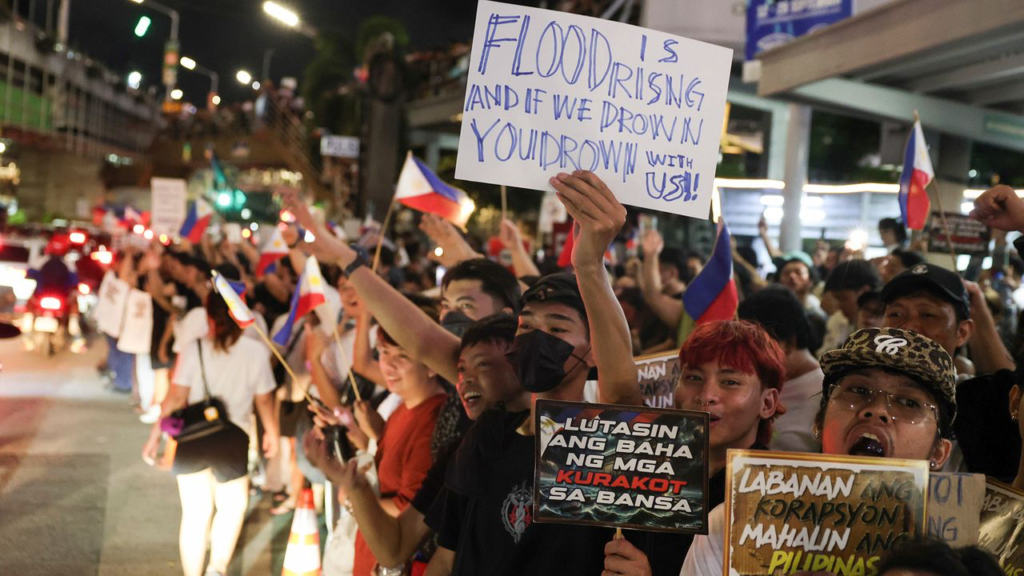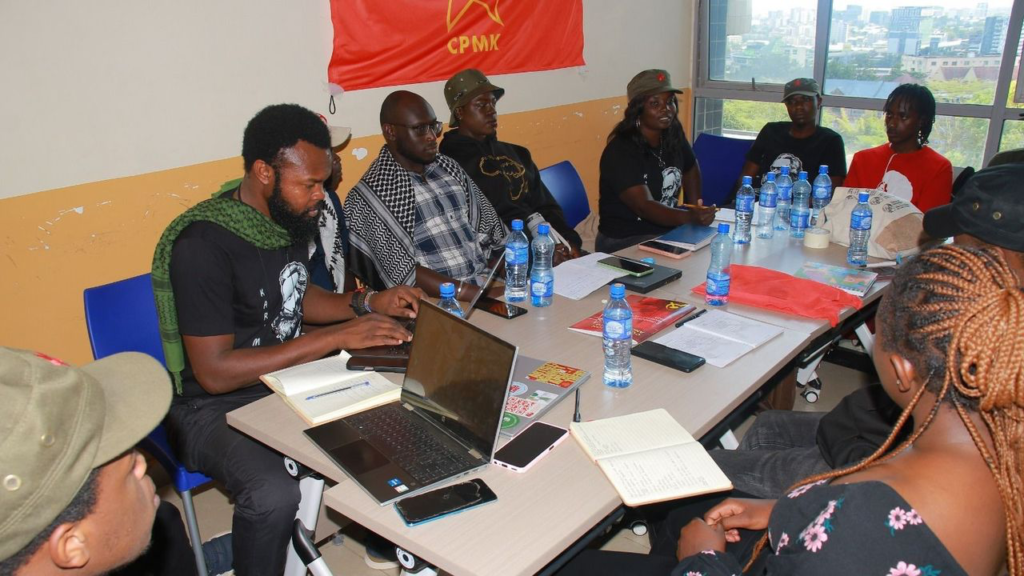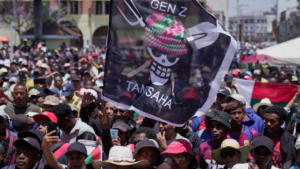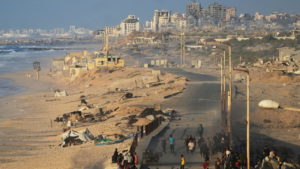Class Foundations—The Objective Crisis and the Betrayal of fake Leaderships
By Sanjaya Jayasekera.
We publish here Part 2 of a series examining the global wave of Gen Z protests, the deepening crisis of revolutionary leadership, and the necessity of fighting for the program of socialist internationalism on the basis of Leon Trotsky’s Theory of Permanent Revolution. Part 1 was published on November 6, 2025 here.
The social crisis driving these predominantly youth-led uprisings is rooted in objective contradictions of global capitalism that no regime change can resolve.
Social Crises
Youth unemployment has reached catastrophic levels: 67 percent in Kenya, 20 percent in Nepal, with similar or worse figures across the former colonial world. In Bangladesh, even university graduates faced a quota system designed to limit access to the few available government positions, which was proposed to privilege Awami League political patronage networks. This educated but jobless generation confronts a future of permanent precarity, unable to secure even the modest middle-class existence their degrees once promised. Reportedly, by end of the 2022 fiscal year, more than 1,700 young Nepalis left the country daily to seek work in the Middle East or Southeast Asia, with peak periods seeing over 2,300 daily departures. Between 2008–09 and 2021–22, a total of 10,666 Nepali migrant workers died in foreign labour destinations, according to the Nepal Labour Migration Report 2022.1

The cost-of-living crisis has made basic survival a daily struggle for hundreds of millions. Food, fuel, and medicine prices have exploded, driven by supply chain disruptions from the COVID-19 pandemic, the economic warfare accompanying the US-NATO proxy war in Ukraine, and the austerity policies dictated by international finance capital. In Sri Lanka, families waited in kilometer-long queues for rice and cooking gas. In the Philippines, catastrophic flooding—itself a product of climate change and the profit-mad real estate speculation that has created sprawling shantytowns without infrastructure—killed scores in 2025, one of the deadliest typhoon seasons on record. The flooding, and the human misery that it causes, are fundamentally the fault of capitalism, not corruption, which is undoubtedly widespread in the ruling circles. Corruption is the product of the nexus between big business, government and the state apparatus, the components of capitalism.
Behind these catastrophic conditions for the masses stands an obscene concentration of wealth at the opposite pole of society. While hundreds of millions confront destitution, billionaire wealth surged by $2 trillion in 2024 alone—equivalent to $5.7 billion per day—growing at triple the rate of 2023. The combined wealth of the world’s billionaires reached $15 trillion, with four new billionaires “minted” every week. In the United States, the ten richest individuals saw their wealth increase six-fold since March 2020, with Elon Musk’s fortune exploding from $33 billion to $469 billion—a fourteen-fold increase that recently culminated in a $1 trillion pay package placing his compensation at $50 million per hour, or three million times the starting wage at a Tesla factory2. This accumulation is inextricably bound to the systematic plundering of the low-and middle-income countries. Most damning is the systematic transfer of value from the poorest countries—the centre of Gen-Z protests—to the super-rich of the major imperialist countries: the financial system extracted $30 million per hour in 2023 from these countries to the richest 1 per cent of the imperialist centers3. Global public debt reached $102 trillion in 2024, with low-income countries—predominantly in Africa, Asia, Latin America and the Caribbean—paying out a record $921 billion in interest to banks, hedge funds and asset managers, a net outflow that exceeded new income by $25 billion4. Some 3.4 billion people live in countries that spend more on interest payments to financial parasites than on health and education combined, with 61 countries devoting at least 10 percent of government revenues to servicing debt. The mechanisms of extraction have shifted: private creditors—BlackRock managing $10 trillion, Vanguard $8 trillion, State Street $4 trillion—now hold 61 percent of the external debt of low- and middle-income countries, extracting 39 percent of all external debt payments between 2020-2025, while borrowing costs for poor countries remain two to four times higher than for the United States.5
As David North observed as early as in 19926, “Not even at the height of its glory did the British Empire possess even a fraction of the power over its colonial subjects that the modern institutions of world imperialism such as the World Bank, the IMF, GATT and the EC routinely exercise over the supposedly independent states of Latin America, Asia, Africa and the Middle East.”7 Meanwhile, according to World Bank data, the number of people living in poverty—approximately 3.5 billion—has barely changed since 1990, and at current growth rates with persistent inequality, ending poverty will take over a century8. This vast polarization is not the result of “policy choices” that could be reversed within capitalism, as liberal reformists claim, but expresses the fundamental law of capitalist accumulation that Marx identified 150 years ago: “Accumulation of wealth at one pole is, therefore, at the same time accumulation of misery, agony of toil, slavery, ignorance, brutality, mental degradation, at the opposite pole.9” The Gen-Z uprisings erupt from this irreconcilable contradiction between socialized production and private appropriation—a contradiction that can be resolved only through the expropriation of the financial oligarchy and the reorganization of economic life under workers’ control.
Trapped in debt burden
As stated, behind the immediate social crises stands the International Monetary Fund (IMF), the primary instrument through which imperialism (domination of finance capital) enforces debt peonage on former colonies. The IMF’s structural adjustment programs, supported by the World Bank, demand the same savage prescriptions everywhere: tax increases on workers and the poor, slashed spending on education and healthcare, privatization of public assets, deregulation to benefit foreign corporations, and currency devaluations that enrich finance capital while impoverishing the masses. When Kenya’s Finance Bill 2024 proposed new levies and taxes, when Sri Lanka’s government defaulted on foreign debt, when Bangladesh’s government cut subsidies—these were not isolated national decisions but directives from Wall Street and the IMF.
The debt crisis afflicting countries where Gen-Z protest movements sprouted reveals the IMF’s hand in systematic extraction of wealth from the former colonial world. Sri Lanka stands at the precipice with a government debt-to-GDP ratio of 96.1 percent in 2024, which is projected to be at 102 percent by the end of 202510, following its 2022 default and subsequent IMF-mandated restructuring that reduced living standards catastrophically, under both presidents, Wickremasinghe and Dissanayake. Kenya’s public debt burden reached 67.8 percent of GDP ($91.3 billion) by June 202511, substantially exceeding the IMF’s average 50 percent threshold for developing countries12, with debt service consuming 67.1 percent of revenues as of May 202413—a staggering burden that directly precipitated the Finance Bill 2024 protests. Bangladesh’s relatively lower government debt ratio of 31.6-32.2 percent of GDP (2023-2024)14 masks the structural adjustment pressures that drove the 2024 uprising, while Nepal’s debt stood at 47.87 percent of GDP in 202415, with projections showing continued increases driven by infrastructure spending and limited revenue mobilization.
The Philippines exemplifies how debt peonage operates even in so-called “emerging economies,” with government debt reaching 60.7 percent of nominal GDP in December 202416, and interest payments rising to 6 percent of GDP in the first Quarter of 202517. Peru maintains a lower debt ratio of 32.7-32.8 percent of GDP as of 202418, yet faces IMF pressure for fiscal consolidation despite economic contraction. Madagascar’s debt burden is estimated to be 51.27 percent of GDP in 2025 and projected to be at 54.64 percent by 2028, with nearly 70 percent of public debt being external and held by official creditors19. Morocco’s debt declined from a pandemic peak 71.5 percent to 67.7-70 percent of GDP in 202420 through aggressive fiscal consolidation that has squeezed living standards.
The African nations of Tanzania, Cameroon, and Nigeria show debt ratios of 41.8 percent, 39.6 percent, and 41.3 percent of GDP respectively in 202421. These figures obscure the reality that Africa’s median public debt stands at 65 percent of GDP, with 25 African countries carrying excess debt or facing high risk of debt distress, and over 60 countries spending more than 10% of government revenue on interest payments alone22. More critically, the composition of African debt has shifted dramatically, with commercial debt now accounting for 43 percent of total debt, up from 20 percent in 2000, meaning debt service costs have exploded even as headline ratios appear manageable23. This debt architecture—whether the crushing burdens in Sri Lanka and Kenya or the “moderate” levels in Sub-Saharan Africa—serves a single function: the subordination of national economies to imperialism’s financial diktat, enforced through IMF structural adjustment programs that demand austerity, privatization, and the destruction of social programs while debt service claims an ever-larger share of government revenues.
Class Composition
The class composition of the Gen-Z movements reveals both their revolutionary potential and the mechanism of their betrayal. University students and unemployed youth provide the initial spark and often the most militant contingent. Their energy, courage, and willingness to confront state violence are undeniable. In Bangladesh, students faced down military units, confronting ruthless government attacks that killed close to a thousand and five hundred protesters; in Kenya, youth stormed parliament; in Nepal, protesters set government buildings ablaze. Yet this student vanguard, drawn predominantly from middle-class backgrounds, cannot provide independent political leadership for the fundamental transformation of society.
The decisive social force is the working class, whose participation in these movements demonstrates its latent power. In Sri Lanka, two one-day general strikes showed worker solidarity with the protesting youth, for whose defence the workers rushed to the main protest site in Colombo when they were attacked by government sponsored thugs on May 9, 2022. In Kenya, following the initial Gen-Z protests, wave after wave of strikes erupted: teachers, civil servants, healthcare workers, airport staff, university lecturers—all protesting low wages, precarious conditions, and privatization. Bangladesh’s garment workers, who produce billions of dollars in exports under brutal exploitation, participated in the protests even as their trade unions worked to demobilize them.
Union Treachery
Yet the working class was systematically prevented from transforming these uprisings into a conscious revolutionary movement for socialism. The critical mechanism of this betrayal was the role of trade union bureaucracies and pseudo-left organizations that function as police forces for the bourgeois order within the workers’ movement.
In Kenya, the trade union federations—the Central Organization of Trade Unions (COTU), the Kenya National Union of Teachers (KNUT), and the Kenya Union of Post-Primary Education Teachers (KUPPET)—all worked to isolate and defeat strikes that followed the Gen-Z uprising.24 When teachers launched strikes demanding salary increases and opposing austerity, KNUT and KUPPET leaders negotiated sellout agreements with the Ruto government, accepting minimal wage increases while abandoning demands around privatization and working conditions. These same union bureaucrats had maintained their positions through the entire period of IMF-dictated austerity, revealing that their function is not to represent workers but to police their struggles within limits acceptable to capital.
In Sri Lanka, the trade unions played an even more directly counterrevolutionary role. During the 2022 uprising demanding Rajapaksa’s resignation, they called two limited one-day general strikes on April 28 and May 6, a response to mass protests and to contain worker discontent over the labor bureaucracy.¹³ But having allowed millions of workers to demonstrate their strength, the union leaders worked frantically to prevent this power from being consolidated into an independent political challenge to capitalism. They refused to call further strikes, opposed the formation of action committees independent of union control, and channeled the movement toward demands for an “interim government” promoted by the bourgeois parliamentary opposition—the Samagi Jana Balavegaya (SJB) and Janatha Vimukthi Peramuna (JVP), and supported by FSP, that would stabilize bourgeois rule. When health workers launched militant strikes,25 the unions worked with the government to suppress them.
In Bangladesh, where garment workers constitute a massive proletarian force producing billions in exports, the trade union federations collaborated26 directly in suppressing worker mobilizations. Even as tens of thousands of garment workers joined the protests against the Hasina government, their unions worked to prevent factory occupations, general strikes, or any independent working-class political intervention. After Hasina’s fall, when garment workers demanded wage increases and better conditions, the unions collaborated with the military-backed Yunus regime to enforce “order” in the factories.27
This pattern reflects the class nature of the trade union bureaucracy. These officials enjoy salaries, privileges, and positions far above those of rank-and-file workers.28 They are integrated into the capitalist state apparatus through labor ministries, tripartite commissions (union-company-government), and corporatist structures.29 Their material interests lie not with the working class they nominally represent30 but with preserving the system that grants them their privileged position.31 The WSWS analysis is definitive: “On these economic and political foundations—financial investments and direct subsidies from the capitalist state—rests a very privileged petty-bourgeois layer which constitutes the bureaucracy of the official unions… [this] only serves to conceal its real social character and the deep-going class antagonisms between it and the working class.”32
The Reactionary Left
Alongside the union bureaucracy operates a network of reactionary left organizations whose function is to provide political cover for this betrayal. These groups—Stalinist, Maoist, various ex-Trotskyist renegades and the pseudo-left tendencies33—present themselves as radical alternatives while systematically blocking the emergence of genuine revolutionary working-class leadership.
In Kenya, the Revolutionary Socialist League (RSL) and the Communist Party Marxist-Kenya (CPM-K) played critical roles in containing the radicalized Gen-Z uprising.34 The RSL, while using revolutionary rhetoric, promoted the very “leaderless”, “no banners”, “no politics” character of the movement that only prevented working-class independent political intervention. Giving left cover to political confusion that benefited the bourgeoisie, Ezra Otieno, a leader of the RSL, said “…this is a good tactic not to have leaders emerging for now, because the government is actively looking for leaders. […] As the RSL, we go there with a purpose, because we must be in solidarity with the masses—we fully agree with what they say. So we go to the streets, we try to organise our people. When joining in, we do not carry banners as people just go without anything, to move around.”35

The CPM-K’s core political orientation centers on defending Kenya’s 2010 Constitution—a document its predecessor, the CPK, helped to draft—while promoting the reformist illusion that implementing its supposedly “progressive articles” will somehow ‘inevitably’ lead to socialism.36 This constitution was drafted by the ruling class with extensive funding from Britain and the United States precisely to stabilize capitalist rule after the 2007 post-election violence. By channeling mass anger into defense of this bourgeois legal framework, the CPM-K ensures that the struggle remains confined within capitalism.
In the Philippines, the pattern of fake-left betrayal reaches its most explicit and politically instructive form. The Stalinist umbrella organization BAYAN (est. in 1985) and the pseudo-left Akbayan party (Citizens’ Action Party) , which emerged out of a merger of a section of the Stalinist Communist Party of the Philippines (CPP) and various Social Democratic organizations in the 1990s37—though historically rivals representing different trajectories of petty-bourgeois politics38—are “coming into ever closer alignment with each other out of their shared orientation to sections of the Philippine bourgeoisie hostile to China”39. When 100,000 people rallied in Manila on September 21, 2025—the 53rd anniversary of Ferdinand Marcos Sr.’s declaration of martial law—these two organizations led separate anti-corruption demonstrations that were, as the WSWS noted, “markedly middle-class” in their political character. However, significantly, the masses who thronged the streets were “not drawn to the protests by an orientation to a particular faction of the bourgeoisie”. In contrast, both BAYAN and Akbayan collaborated openly with bourgeois parties, both worked systematically to prevent the emergence of an independent working-class movement, and both channeled mass anger into the dead-end of bourgeois factional warfare between the Marcos and Duterte camps. The ultimate orientation of these demonstrations, “despite some anti-Marcos slogans and banners” was “towards an alliance against the forces of Duterte,” “which seeks to moderate Philippine ties to the United States in order to secure greater economic investment from China”.

The treacherous role of BAYAN and Akbayan must be understood not as an aberration but as the logical outcome of their fundamental political orientation toward class collaboration. BAYAN, being one of Maoist CPP’s front organizations,40 has for decades promoted the “two-stage theory” that subordinates the working class to a supposed “progressive national bourgeoisie” in a prolonged “national democratic” struggle that perpetually postpones socialist revolution.41 Akbayan, which bills itself as a “social democratic” alternative, has fully integrated into bourgeois parliamentary politics, holding seats in Congress and supporting imperialist-aligned bourgeois politicians. Its nationalist, opportunist and class collaborationist politics are the continuation of the Stalinist politics of the CPP.42 Once again, these forces unite in a shared function: blocking the independent political mobilization of the Philippine working class and subordinating it to bourgeois factions aligned with Washington’s strategic objectives in the Indo-Pacific. Their increasing alignment reflects not personal reconciliation but the inexorable logic of their petty-bourgeois politics in the epoch of imperialist war. As the Philippines is positioned on the “frontlines of Washington’s preparations for war with China,” both BAYAN and Akbayan have effectively become instruments for integrating mass opposition into imperialism’s war agenda, despite whatever anti-imperialist rhetoric they may occasionally deploy for tactical purposes.43
Anti-Corruption Campaign
The anti-corruption framework promoted by both BAYAN and Akbayan party represents a contemporary disguise for the class-collaborationist politics that Stalinism has peddled globally for a century. Where Stalin’s “two-stage theory” openly called for a “bloc of four classes” including the “progressive national bourgeoisie,”44 today’s pseudo-left calls for unity of “the people” against “corrupt elites”, as part of “completing democratic tasks”. Both formulations divide the bourgeoisie into progressive and reactionary camps, subordinate the working class to a bourgeois faction, and systematically block the fight for socialist revolution. WSWS explained, “The banner of an anti-corruption campaign is a political dead-end. It is politically amorphous and can serve as an umbrella for bringing together a wide range of bourgeois and petty-bourgeois parties and organisations, including those of the far-right.”45 In the Philippines, this takes the concrete form of supporting bourgeois investigations into the Duterte camp while aligning with the Marcos government’s integration into US military structures. The strategic function becomes clear: ruling-class factions weaponize corruption charges against each other—Marcos launching investigations to preempt Duterte attacks, Duterte forces using the Senate to expose Marcos allies—while BAYAN and Akbayan provide a pseudo-radical veneer to what is fundamentally a reshuffling of positions within the capitalist ruling elite. The working class, which faces catastrophic unemployment, climate disasters, falling wages, and the prospect of being used as cannon fodder in a US war against China, is thereby prevented from organizing independently and advancing its own class interests.
This analysis of the Philippines protests applies universally. Indeed, in Sri Lanka, it was on the basis of an anti-corruption platform that the JVP/NPP exploited the overwhelming public hostility to all the traditional capitalist parties to come to power and implement the IMF’s austerity program. Nepal’s military-installed technocratic government justified itself through promises to combat corruption. Bangladesh’s banker Yunus positioned himself as above the corrupt political establishment.
But corruption is not an aberration from the system but an inherent feature of the property relations of monopoly capitalism. Private ownership of the means of production creates the material conditions for officials to enrich themselves. The bourgeois state exists precisely to defend the interests of the capitalist class, making “clean capitalism”, advocated by IMF, a contradiction in terms. As with all other democratic tasks, the protection of public assets against official corruption rests on the working class as part of its revolutionary act of expropriating the financial aristocracy, capitalist oligarchy and the abolition of the state itself.
Regime change serves imperialism
The wave of Gen-Z protests succeeded in a couple of countries effecting regime changes, replacing one set of representatives of the bourgeoisie in power with another. The mass uprisings, born from genuine rage at intolerable conditions, are channeled through anti-corruption frameworks into support for “clean” administrators who implement the same or worse policies. Bangladesh’s Yunus, with his Western connections, promises “robust economic reforms.” Kenya’s Ruto-Odinga coalition continues austerity while designating the country a US “major non-NATO ally.”
Wickremesinghe in Sri Lanka used police-state repression to enforce IMF demands, while, his successor, president Dissanayaka’s government is employing the whole state machinery, the parliament, media and usual rhetoric of deception, and its trade union bureaucracy to contain and suppress class struggles against its continued implementation of the IMF dictates to the letter. Nepal’s technocrats position themselves above politics while preserving capitalist property relations.
The working class and rural masses bear the full weight of this betrayal by the pseudo-left and trade union bureaucracies. New regimes perpetuate austerity programs and serve imperialist interests under fresh political banners—“progressive” coalitions, “anti-corruption” governments, or military-backed technocrats—while preserving capitalist property relations intact. Workers who risked their lives confronting state violence now face renewed demands for “belt-tightening” and “fiscal discipline” to achieve “economic stability”—the identical rhetoric that drove them into the streets. The revolutionary energy that toppled governments dissipates into exhaustion and demoralization as the pseudo-left channels mass anger back into support for one capitalist faction against another. This political disorientation creates fertile conditions for right-wing and fascistic forces to exploit mass disillusionment. Demagogues channel legitimate working-class rage toward scapegoats—immigrants, ethnic minorities, “corrupt politicians”—while leaving capitalist exploitation and imperialist domination untouched. Parliament and elections function as the critical mechanisms through which the bourgeoisie reconsolidates its rule, channeling mass opposition into safe constitutional frameworks that subordinate the working class to bourgeois factional warfare.
The historical experiences of Italy (1920-22), Germany (1933), and France (1936-39) demonstrate with tragic clarity how betrayed revolutionary movements can be transformed into their opposite. In each case, the political betrayals of Social Democracy and Stalinism—the refusal to fight for workers’ power, the subordination of the working class to the “democratic” bourgeoisie through Popular Fronts, the suppression of independent working-class political organization—paralyzed and demoralized the masses, clearing the path for fascism’s brutal consolidation. As Trotsky emphasized in analyzing these catastrophes, “Fascism is a particular governmental system based on the uprooting of all elements of proletarian democracy within bourgeois society,” made possible only by the prior betrayal of revolutionary leadership.46 The same dialectic operates in contemporary Gen-Z uprisings: pseudo-left organizations systematically prevent independent working-class mobilization under socialist leadership, creating the conditions for bourgeois reaction to reassert itself through both parliamentary mechanisms and, where necessary, authoritarian consolidation.
These outcomes constitute a stark warning: regime change within the framework of capitalism represents a strategic dead-end for the working class. The fundamental lesson of the Gen-Z uprisings is not that mass movements cannot overthrow governments—they demonstrably can—but that overthrowing governments without overthrowing the capitalist system produces only a reshuffling of personnel within the same exploitative structure. The task confronting workers and youth is not to stop their struggle at the doors of parliament or the presidential palace, but to carry it forward to the expropriation of the capitalist class and the establishment of workers’ power. Only the conquest of political power by the working class, organizing the rural masses and the oppressed middle class under its leadership, can overcome the dead-ends that preserve the very system responsible for exploitation, mass unemployment, climate catastrophe, and imperialist war.
To be continued…
- Yearender 2022: More Nepalis leave for foreign jobs in 2022, https://kathmandupost.com/money/2022/12/29/more-nepalis-leave-for-foreign-jobs-in-2022
↩︎ - WSWS, “Elon Musk’s $1 trillion payout and the case for expropriation” (8 November 2025)
https://www.wsws.org/en/articles/2025/11/08/gqvw-n08.html
↩︎ - https://www.weforum.org/stories/2025/01/oxfam-new-report-inequality-colonialism/
↩︎ - WSWS, “The World of Debt” https://www.wsws.org/en/articles/2025/08/24/errm-a24.html
↩︎ - Ibid ↩︎
- David North, ‘Capital, Labor and the Nation-State’ (World Socialist Web Site, 18 June 1992)
https://www.wsws.org/en/special/library/fi-20-1/02.html
↩︎ - Statement of the International Committee of the Fourth International Globalization and the International Working Class, International finance vs. the capitalist state
https://www.wsws.org/en/special/library/globalization-international-working-class/07.html
↩︎ - Oxfam “Takers Not Makers” report
https://www.oxfam.org/en/takers-not-makers-unjust-poverty-and-unearned-wealth-colonialism
↩︎ - Karl Marx, Capital, Volume 1, Chapter 25
↩︎ - https://tradingeconomics.com/sri-lanka/government-debt-to-gdp
↩︎ - https://www.ecofinagency.com/news-finances/0910-49407-kenya-s-public-debt-reaches-67-8-of-gdp-in-june-2025-finance-minister-says
↩︎ - https://cytonnreport.com/topicals/review-of-kenyas-1#:~:text=Consequently%2C%20the%20debt%20to%20GDP,collection%20and%20prudent%20debt%20repayments ↩︎
- https://www.cytonn.com/topicals/review-of-kenyas-1
↩︎ - https://tradingeconomics.com/bangladesh/government-debt-to-gdp ↩︎
- https://www.statista.com/statistics/422519/national-debt-of-nepal-in-relation-to-gross-domestic-product-gdp/
↩︎ - https://www.ceicdata.com/en/indicator/philippines/government-debt–of-nominal-gdp
↩︎ - https://cpbrd.congress.gov.ph/wp-content/uploads/2025/08/DP13-Sustaining-Growth-Managing-Debt-FINAL.pdf
↩︎ - https://www.ceicdata.com/en/indicator/peru/government-debt–of-nominal-gdp
↩︎ - https://documents1.worldbank.org/curated/en/099042925131559525/pdf/BOSIB-a6f0fd17-800e-44dd-b2c0-c4e8f502a103.pdf ↩︎
- https://tradingeconomics.com/morocco/government-debt-to-gdp
↩︎ - https://businessday.ng/news/article/10-least-indebted-african-countries-in-2024-imf/
↩︎ - https://africatalyst.com/trapped-by-mounting-debt-africa-pushes-for-a-financial-reset/
↩︎ - https://www.afdb.org/en/news-and-events/annual-meetings-2024-old-debt-resolution-african-countries-cornerstone-reforming-global-financial-architecture-70791
↩︎ - WSWS, ‘Strike wave erupts across Kenya despite trade unions’ attempt to strangle’ it”https://www.wsws.org/en/articles/2024/09/10/swrk-s10.html ↩︎
- WSWS, ‘Sri Lankan health employees strike over fuel shortages and inability to travel to work’ https://www.wsws.org/en/articles/2022/07/05/msnn-j05.html
↩︎ - WSWS, ‘Bangladeshi prime minister threatens protesting garment workers’ https://www.wsws.org/en/articles/2022/06/13/ojdc-j13.html
↩︎ - WSWS, ‘Tens of thousands of Bangladeshi garment workers continue protests’ https://www.wsws.org/en/articles/2024/11/15/menp-n15.html
↩︎ - WSWS, “A wave of defeats and betrayals” (from The Globalization of Capitalist Production) https://www.wsws.org/en/special/library/globalization-international-working-class/28.html
↩︎ - WSWS, “‘Biden gets it!’: Britain’s trade unions make their corporatist pitch to government and business” https://www.wsws.org/en/articles/2021/09/20/tuni-s20.html
↩︎ - WSWS, “A fresh lesson: The end of the Detroit newspaper strike and the crisis of the labor movement”: “The bureaucracy itself is a privileged, upper-middle class social layer. Because it is tied to the capitalist system, it seeks to conceal from the working class the real nature of this system and the position of workers within it.” https://www.wsws.org/en/articles/2001/01/iwb-j04.html
↩︎ - WSWS, David North, “Trotsky’s Last Year” (01 September 2020) https://www.wsws.org/en/articles/2020/09/02/ann5-s02.html
↩︎ - WSWS, “Sellout at Arconic: The latest showdown between workers and the unions” https://www.wsws.org/en/articles/2022/06/03/pers-j03.html
↩︎ - David North, “The theoretical and historical origins of the pseudo-left” (World Socialist Web Site, 18 July 2012), https://www.wsws.org/en/articles/2015/02/24/pseu-f24.html
↩︎ - WSWS, ‘One year since the Gen-Z Uprising in Kenya: The need for a socialist and internationalist strategy’ (24 June 2024) https://www.wsws.org/en/articles/2025/06/24/yvsc-j24.html
↩︎ - WSWS, “Kenya’s Gen Z insurgency, the strike wave and the struggle for Permanent Revolution—Part 3” https://www.wsws.org/en/articles/2024/10/06/xrfc-o06.html
↩︎ - WSWS, “Kenya’s National People’s Council: A petty-bourgeois nationalist trap for the Gen Z revolt” https://www.wsws.org/en/articles/2025/08/21/hkao-a21.html; “Stalinist Communist Party Marxist-Kenya seeks new political trap for rising discontent among workers, youth—Part Three” https://www.wsws.org/en/articles/2025/03/06/wgqk-m06.html
↩︎ - WSWS, “Duterte allies dominate Philippine midterm election campaign” (21 January 21 2019) https://www.wsws.org/en/articles/2019/01/21/phil-j21.html
↩︎ - Brief History, https://www.akbayan.org.ph/our-story#:~:text=Even%20with%20these%20efforts%2C%20democracy,that%20often%20happen%20in%20politics
↩︎ - WSWS, Major protests against corruption in the Philippines (21 September 2025)
https://www.wsws.org/en/articles/2025/09/22/zhyf-s22.html
↩︎ - WSWS, ‘Philippine “left” quarrels over election’ (13 November 2012)
https://www.wsws.org/en/articles/2012/11/left-n13.html
↩︎ - Ibid ↩︎
- Ibid ↩︎
- WSWS, “The Philippine ‘left’ and the constitutional crisis” (20 December 2011)
https://www.wsws.org/en/articles/2011/12/phil-d20.html
↩︎ - WSWS, “70 years after the Chinese Revolution: How the struggle for socialism was betrayed” (24 October 2019)
https://www.wsws.org/en/articles/2019/10/24/lect-o24.html
↩︎ - WSWS, “Major protests against corruption in the Philippines” (22 September 2025)
https://www.wsws.org/en/articles/2025/09/22/zhyf-s22.html
↩︎ - WSWS, The rise of fascism in Germany and the collapse of the Communist International”
https://www.wsws.org/en/articles/2005/10/le9-all.html
↩︎









